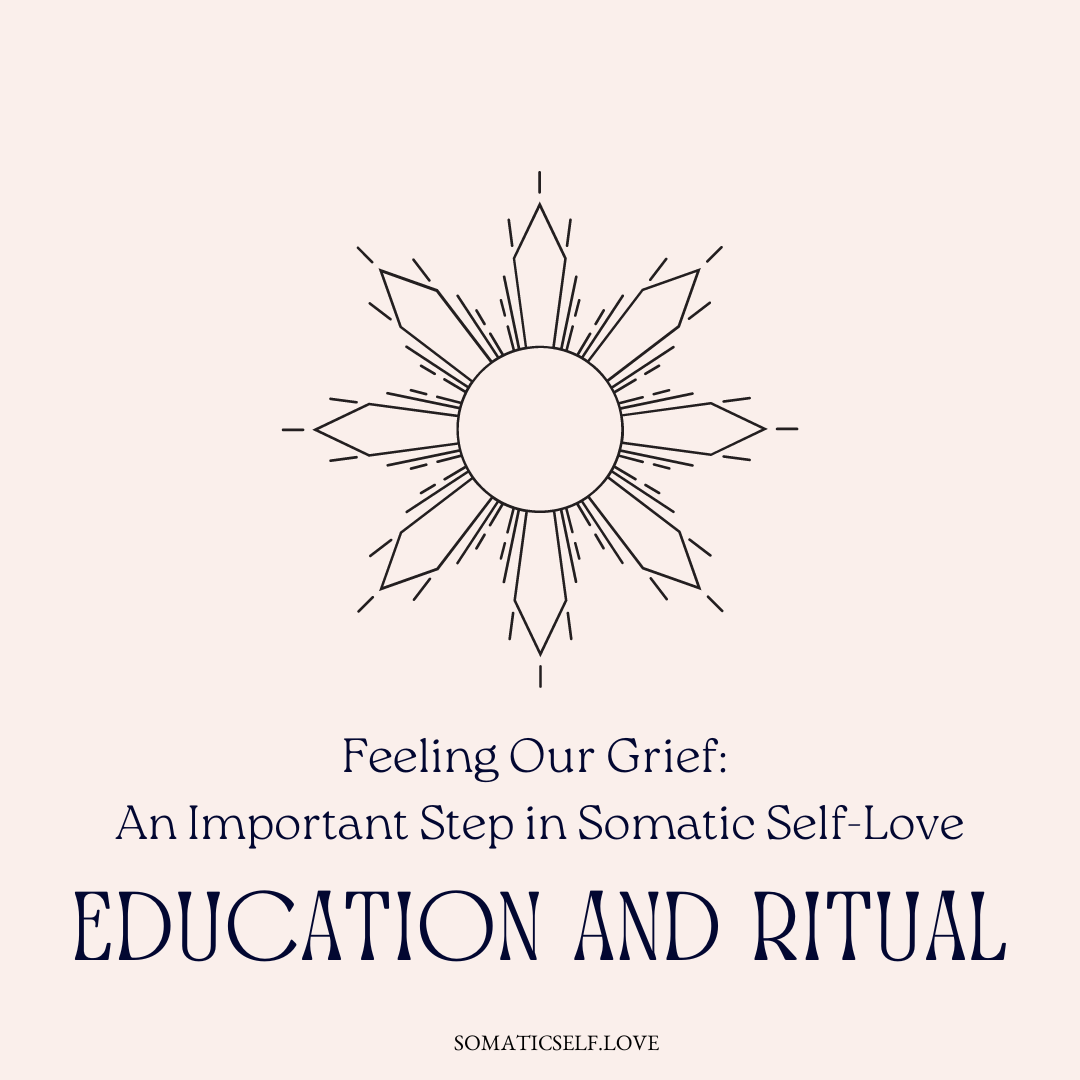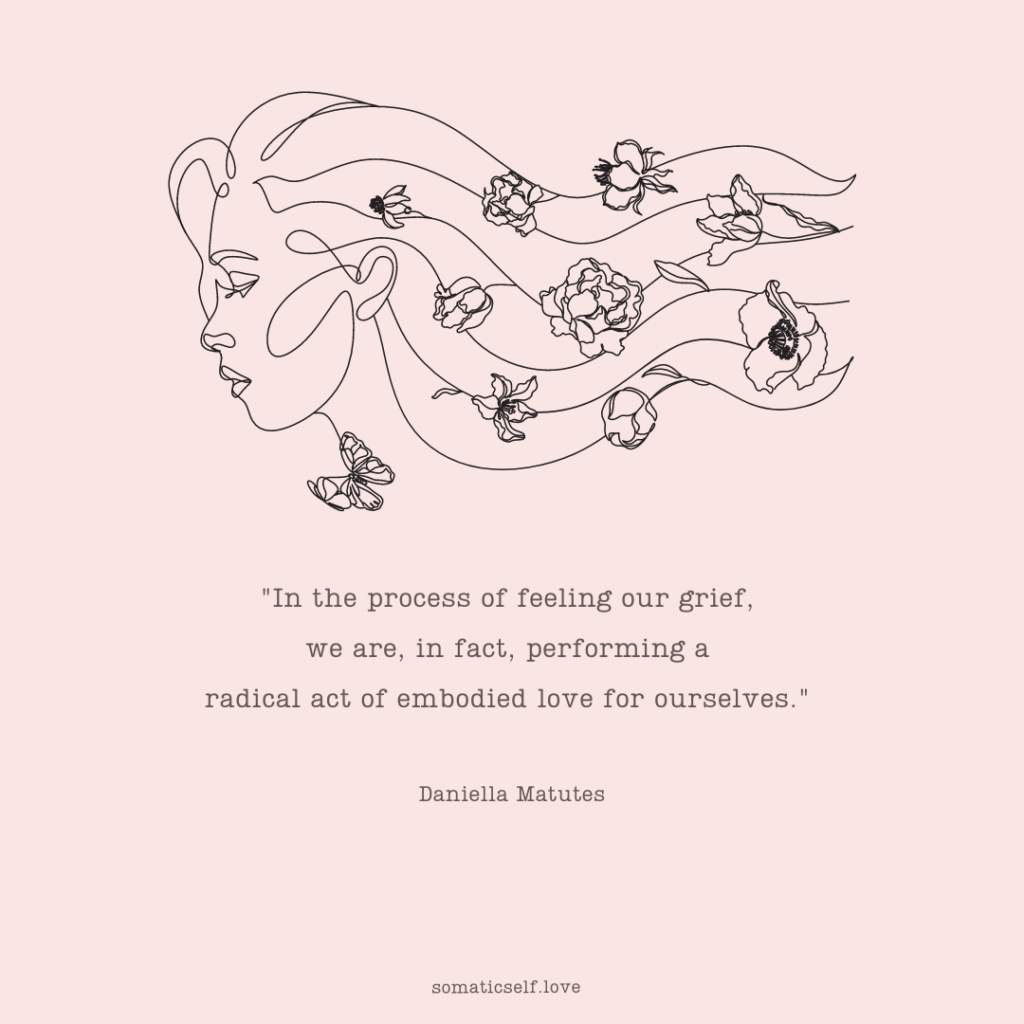Feeling Our Grief: An Important Step in Somatic Self-Love

“In the process of feeling our grief, we are, in fact, performing a radical act of embodied love for ourselves.”
Daniella Matutes
The journey towards somatic self-love is often perceived as a linear, only “good” feelings trajectory: a path that, once embarked upon, leads towards positive self-affirmation and acceptance. This simplifies the complex emotional roadmap that forms the journey to somatic self-love. A crucial, yet often overlooked, part of this voyage is the engagement with and understanding of grief. It is in the conscious act of naming our grief, immersing ourselves in its depth, and letting it move through us, that we can nurture somatic self-love.
Grief is a multidimensional emotional, mental, physical and spiritual response to loss and change. And, an inevitable part of the human experience. It is associated not only with death, but with a myriad of losses we navigate throughout our lives: the end of relationships, changes in our health, shifts in our identity, and societal changes that impact our sense of belonging and security. By embracing and acknowledging our grief, rather than fighting, numbing, suppressing or rushing through it, we engage in an act of radical somatic self-love.
“Grief does not change you, Hazel. It reveals you.”
John Green, The Fault in Our Stars
This revelation is the cornerstone of somatic self-love.
Somatic Means The Living Body in its Wholeness
Somatic, derived from the Greek word “soma,” means the living body in its wholeness – a holistic perspective that considers the entirety of a person’s being. This includes not just the physical body, but also the emotional, mental, and energetic aspects of a person.

In this context, the term “somatic” is often used in relation to therapies, healing practices, or philosophies that emphasize the interconnectedness of mind, body, and spirit. Somatic therapies, for example, focus on the relationship between the body and the psychological well-being of a person, addressing how bodily traumas, emotions, and energies can impact mental and physical health.
Here’s a more comprehensive definition:
Somatic: Pertaining to the holistic view of a person, encompassing their physical body, emotional state, logical thinking, and energetic presence. It underscores the interconnectedness of all these aspects and their collective contribution to a person’s overall well-being and existence. In various healing and therapeutic practices, a somatic approach implies addressing and harmonizing these various aspects to achieve overall health and wellness.
Listen to the Wisdom of Our Bodies
Somatic self-love is an embodied practice of self-love. It invites us to listen to the wisdom of our bodies, to honor our physical and emotional responses to life, and to cultivate an intimate relationship with our embodied selves.
Feeling our grief, in its raw and unfiltered form, allows us to engage in this somatic practice of self-love. As we sit with our sorrow, we learn to be with discomfort, to hold space for ourselves in our moments of deepest pain, and to extend compassion and understanding to our grieving selves. This is a somatic process: our bodies physically respond to grief, and by acknowledging and honoring this response, we deepen our connection with our own bodily wisdom.
The Body’s Response to Grief
Our body’s response to grief is multifaceted and complex. It may manifest as physical symptoms such as fatigue, insomnia, changes in appetite, or a general sense of unwellness. Our bodies may feel heavy, or we may experience a sense of disconnection from our physical selves. These responses are not aberrations to be corrected but are a part of the natural process of grieving.
A study titled “Mind-body Interactions” in the journal Dialogues in Clinical Neuroscience (Lakhan and Schofield, 2013) discusses how emotional, neurological, and physical elements of the human experience are interconnected.
“Our results confirm a significant manifestation of grief in physical symptoms among the bereaved, indicating the profound interconnectedness of emotional and physical well-being.”
Lakhan and Schofield, 2013
It is through acknowledging these responses, and through moving with them rather than against them, that we can cultivate somatic self-love in the midst of grief. This involves recognizing the signals our bodies send us, respecting our need for rest and healing, and nurturing our bodies through practices that promote physical and emotional wellbeing.
To engage in somatic self-love in the face of grief is to choose the path of radical self-acceptance. It is to honor the totality of our human experience, to embrace the depth of our emotions, and to affirm the wisdom of our bodies. It is to validate that our grief, in all its forms, is a testament to our capacity for love and connection, and a profound signal of our inherent self-worth.
A Somatic Self-Love Ritual for Grief
The process of navigating through the labyrinth of grief can often be a formidable journey. Yet, the incorporation of somatic self-love rituals can serve as a beacon of comfort and support during these trying times. The below ritual offers a detailed step-by-step guide capable of aiding you in fostering self-love and compassion amidst this challenging period.
Step 1: Set the Scene
Identify a quiet and serene space where disturbance is minimal. This could be a cherished part of your house, a tranquil outdoor spot, or any locale that imbues a sense of safety and tranquility. Consider enhancing the ambiance with the soft glow of a candle, the soothing notes of gentle music, or the reassuring presence of an object that brings you comfort.
Step 2: Grounding
Establish yourself in a comfortable position, either sitting or lying down. Close your eyes and concentrate on your breathing patterns: the flow of air as it enters and exits your body, the rhythmic rise and fall of your chest. This exercise aims to anchor you in the present moment, creating a sense of groundedness.
Step 3: Body Scan
Initiate the scan from your toes, gradually moving your focus upward through your body. Pay heed to any sensations that emerge during this process, which may range from tension to a sense of warmth, coolness, tingling, or even numbness. Refrain from attempting to alter any sensation, instead simply observe. This technique can enhance your attunement to your body’s needs and responses.
Step 4: Acknowledge Your Emotions
Recognize and identify the emotions coursing through you. Grief often ushers in a myriad of emotions, spanning from sadness and anger to relief or confusion. Acknowledge these feelings without casting judgement. Bear in mind that it is perfectly acceptable to experience whatever emotions present themselves.
Step 5: Self-Compassion Break
Place your hand over your heart or another comforting location on your body. Visualize warmth and compassion coursing from your hand into your body. Address yourself with the same kindness and understanding you would afford to a dear friend experiencing pain. You might affirm, “I’m here for you. It’s okay to feel this way.”
Step 6: Movement
If it feels appropriate, incorporate some gentle movement. This could be as simple as stretching your arms skyward. This reminds us that grief, in its essence, is not merely a psychological experience, but a profoundly corporeal one. The body, with its intricate mapping of grief, plays a crucial role in this process.
Step 7: Visualization
Visualize a place where you are enveloped in safety and love. Engage all your senses in imagining this place. What does it look like? What does it smell like? What sounds populate this space? This visualization exercise can provide a sense of peace and comfort.
Step 8: Gratitude
Contemplate something for which you are profoundly grateful. This could be a person, an experience, or something as simple yet comforting as a warm cup of tea. Concentrating on elements of gratitude can usher in a sense of perspective and positivity.
Conclude the ritual by taking several more deep, grounding breaths, then gradually draw your awareness back to your immediate surroundings. It’s important to remember that everyone’s experience with grief is unique, devoid of any ‘right’ or ‘wrong’ ways to feel or heal. Use this ritual as a guide, but feel free to modify it to better suit your needs and emotional landscape.
Embrace Healing Through Breath: Somatic Self-Love Breathwork Session
Grief is a complex, multifaceted experience, often leaving us feeling both emotionally and physically drained. But imagine if you could navigate this process in a more grounded, compassionate way? Our Somatic Self-Love Breathwork session is designed to guide you towards that possibility.
Breathwork is a potent tool that connects us with our body, our emotions, and our innate capacity to heal. It invites us to listen to the wisdom of our bodies, to honor our physical and emotional responses to life, and to cultivate an intimate, compassionate relationship with our embodied selves.
By participating in this session, you’ll learn how to use breathwork to sit with your grief, to be comfortable with discomfort, and to extend compassion and understanding to your grieving self. This is a somatic process: our bodies physically respond to grief, and by acknowledging and honoring this response, we deepen our connection with our own bodily wisdom.
Sign up for our Somatic Self-Love Breathwork session today. Experience the power of breath in healing, in self-love, in being with grief. Breathe in peace, breathe out stress. Reconnect with your body, and allow your inner strength to guide your healing journey.
You are not alone in your grief. Join us and discover the empowering potential of breathwork.